Avebury Chapter II Rowldrich
Avebury Chapter II Rowldrich is in Avebury Chapter II.
1. A situation on high ground, open heaths, by heads of rivers.
ROWLDRICH is a temple of the Druids of the first kind, a circular work which has been often taken notice of in print, lying in the north-west part of Oxfordshire: upon high ground, where the counties of Oxford, Warwick, and Glocester meet. 'Tis near the town of Chippin-Norton. Two rivers rise here, that run with quite contrary directions; the Evenlode towards the south part of the kingdom, which joining the Isis below Woodstock, visits the great luminary of Britain, Oxford, and then meets the Thames at Dorchester [Map], the ancient Episcopal see of the Mercian kingdom. At this Dorchester are fine remains both of Saxon church [Map] antiquity, of Roman, and of British. The inquisitive that prefer our own country antiquities to the vain tour of foreign, will find much of curious amusement there. The other river Stour runs from Rowldrich directly north, to meet the Avon at Stratford [Map], thence to the Severn sea. So that Rowldrich must needs stand on very high ground, and to those that attentively consider the place itself, it appears to be a large coped hill, on the summit of an open down; and the temple together with the Archdruid's barrow hard by, stand on the very tip of it, having a descent every way thence: and an extensive prospect, especially into Glocestershire and Warwickshire. The country hereabouts was originally an open, barren heath; and underneath, a quarry of a kind of rag stone. At present near here are some inclosures, which have been ploughed up. The major part of our antiquity remains: tho' many of the stones have been carried away within memory, to make bridges, houses, &c.
2. 'Tis an open temple of a circular form, made of stones set upright in the ground. The stones are rough and unhewn, and were (as I apprehend) taken from the surface of the ground. I saw stones lying in the field north of Norton, not far off, of good bulk, and the same kind as those of our antiquity. There are such in other places hereabouts, whence the Druids took them: tho' in the main, carryed off ever since, for building and other uses.
3. We observe the effect of the weather upon these works. This we are treating of, stands in a corner of the hedge of the inclosure, near the northern summit of the hill, "a great monument of antiquity," says the excellent Mr. Camden, "a number of vastly great stones placed in a circular figure. They are of unequal height and shape, very much ragged, impaired and decayed by time." Indeed as from hence we must form some judgment of their age, we may pronounce them not inferior to any in that respect; corroded like worm-eaten wood, by the harsh jaws of time, and that much more than Stonehenge, which is no mean argument of its being the work of the Druids.
4. We are led to this conclusion from the name. Mr. Camden calls them Rolle-rich stones. Dr. Holland in his note says, in a book in the Exchequer (perhaps he means doomsday book) the town adjacent, (whence its name) is Rollendrich, if it was wrote exactly, I suppose it would be Rholdrwyg, which means the Druids' wheel or circle. Rhwyll likewise in the British, is cancelli, for these stones are set pretty near together, so as almost to become a continued wall, or cancellus. Further, the word Roilig in the old irish language, signifies a church; then it imports the Druids' church, chancel, or temple, in the first acceptation of the word. We may call this place the Gilgal of Britain, to speak in the oriental manner, a word equivalent to the Celtic Rhol, a wheel or circle, which gave name to that famous camp or fortress where the host of Israel first pitched their tents in the land of Canaan; after they passed the river Jordan in a miraculous manner, dry-shod, as 'tis described in the sublimest manner, and equal to the dignity of the subject, in Joshua iv. There also we read, that Joshua caused twelve men, a man out of each tribe, to pitch twelve stones in the channel of the river Jordan, where the ark stood whilst the people passed over, when the stream was cut off; they were set there for a memorial. And they likewise took up twelve stones out of the bed of the river, and Joshua pitched them in Gilgal, in a circular form, which gave name to the place, meaning a rhowl or wheel. And to this he alludes in the next chapter, in that passage, which otherwise is difficult to be understood; for here Joshua circumcised the people, that rite having been omitted in the young race during their peregrination in the wilderness: "And the LORD said unto Joshua, this day have I rolled away the reproach of Egypt from off you; wherefore the name of the place is called Gilgal unto this day."
1724. View of the Kistvaen at Rowldrich from the East. A. the Druid temple [Map] at a distance.
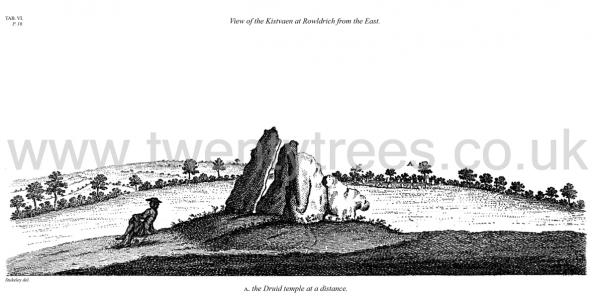
Commentators not apprehending this, run into many odd solutions, as not seeing a reason between name and thing. Some therefore suppose it so called, because from hence Joshua conquered all his enemies round about, and the like. But the truth is, Joshua set the stones in a circular form, like the ancient temples; but placed no altar there, because they had no need to use it as a temple, where the tabernacle was present, therefore called it simply the wheel. So I doubt not but the altar which Moses built under mount Sinai, with twelve pillars, was a circular work, as our Druid temples, Exod. xxiv. 4. The like we ought to think of the altar which Moses built, and called Jehovah Nissi, which the heathen perverted into Jupiter Nyseus, or Dionysus, Exod. xvii. 15. The like must be affirmed of all the patriarchal altars of Abraham, Isaac, and Jacob. These works of ours prove it, which are but little later in time, and made in imitation of theirs; and without a pun, or false logic, these matters may be said to prove each other in a circle; where 'tis absurd to demand any positive proof thro' extreme distance of times and places. I apprehend nothing further ought to be expected from us than to lay together circumstantial evidence, a concurrence of numerous and strong verisimilitudes; as is now the case with us concerning Rowldrich.
1724. 5. We very justly infer this is a temple of the Druids, from the measure it is built upon. In a letter from Mr. Roger Gale to me, dated from Worcester, Aug. 19, 1719, having been to visit this antiquity at my request, he tells me, the diameter of the circle is 35 yards. So the bishop of London writes, the distance at Stonehenge from the entrance of the area to the temple itself is 35 yards; so the diameter of Stonehenge is 35 yards. We suppose this is not measured with a mathematical exactness; but when we look into the comparative scale of English feet and cubits, we discern 60 cubits of the Druids is the measure sought for. The diameter of the outer circle of Stonehenge, and this circle at Rowldrich, are exactly equal.
I have repeated the table of the Druid cubits collated with our English feet, which will be of service to us throughout this work, plate II.
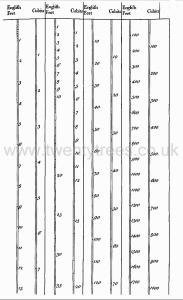 Plate II
Plate II
1724. The circle itself is composed of stones of various shapes and dimensions, set pretty near together, as may best be seen by the drawings, Table III, IV. They are flattish, about 16 inches thick. Originally there seems to have been 60 in number, at present there are 22 standing, few exceeding 4 foot in height; but one in the very north point much higher than the rest, 7 foot high, 5½ broad. There was an entrance to it from the north-east, as is the case at Stonehenge. Ralph Sheldon, esquire, dug in the middle of the circle at Rowldrich, but found nothing.
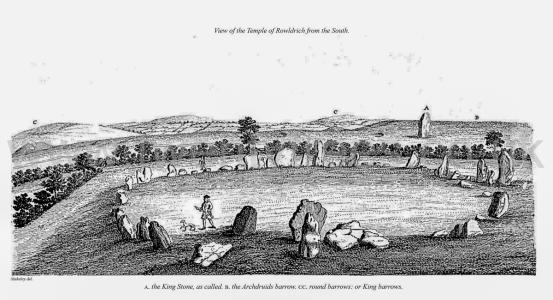
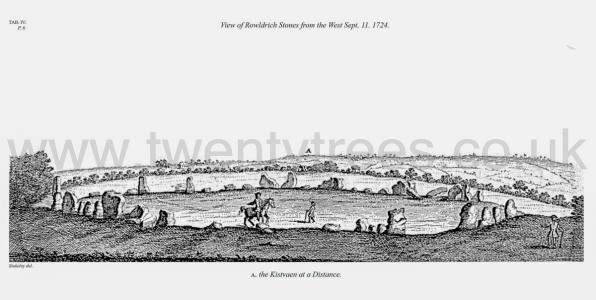 Tables III and IV.
Tables III and IV.
6. Another argument of its being a Druid temple, is taken from the barrows all around it, according to the constant practice in these places. To the north-east is a great tumulus or barrow of a long form, which I suppose to have been of an arch-druid. Between it and our temple is a huge stone standing upright, called the kingstone [Map]; the stone is 8 foot high, 7 broad, which, together with the barrow, may be seen in Tables III, V. but the barrow has had much dug away from it. 'Tis now above 60 foot in length, 20 in breadth, flattish at top.
I know not whether there were more stones standing originally about this barrow, or that this belonged to some part of the administration of religious offices in the temple, as a single stone.
In the same plate may be seen another barrow, but circular, below the road to the left hand, on the side of the hill. Under it is a spring-head running eastward to Long Compton. This barrow has had stone-work at the east end of it. Upon this same heath eastward, in the way to Banbury, are many barrows of different shapes, within sight of Rowldrich; particularly, near a place called Chapel on the heath, is a large, flat, and circular tumulus, ditched about, with a small tump in the center: this is what I call a Druid's barrow; many such near Stonehenge, some whereof I opened; a small circular barrow a little way off it. There are on this heath too, many circular dish-like cavities, as near Stonehenge, we may call them barrows inverted.

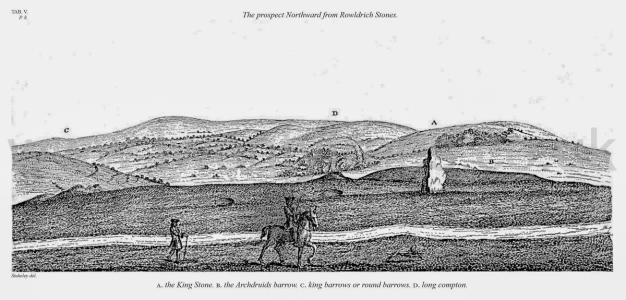 Tables III and V.
Tables III and V.
1724. Not far from the Druid's barrow I saw a square work, such as I call Druids' courts or houses. Such near Stonehenge and Abury. 'Tis a place 100 cubits square, double-ditched. The earth of the ditches is thrown inward between the ditches, so as to a raise a terrace, going quite round. The ditches are too inconsiderable to be made for defence. Within are seemingly remains of stone walls. 'Tis within sight of the temple, and has a fine prospect all around, being seated on the highest part of the ridge. A little further is a small round barrow, with stone-work at the east end, like that before spoken of near Rowldrich; a dry stone wall or fence running quite over it, across the heath.
Return we nearer to the temple, and we see 300 paces directly east from it in the same field, a remarkable monument [Whispering Knights Burial Chamber [Map]?] much taken notice of; 'tis what the old Britons call a Kist vaen or stone chest; I mean the Welsh, the descendants of those invaders from the continent, Belgæ, Gauls and Cimbrians, who drove away the aboriginal inhabitants, that made the works we are treating of, still northward. Hence they gave them these names from appearances; as Rowldrich, the wheel or circle of the Druids; as Stonehenge they called choir gaur, the giants' dance; as our saxon ancestors called it Stonehenge, the hanging-stones, or stone-gallows. Every succession of inhabitants being still further removed from a true notion and knowledge of the things.
Our Kist vaen is represented in plates VI. and VII. One shews the foreside, the other the backside; so that there needs but little description of it. 'Tis composed of six stones, one broader for the back-part, two and two narrower for the sides, set square to the former; and above all, as a cover, a still larger. The opening is full west, to the temple, or Rowldrich. It stands on a round tumulus, and has a fine prospect south-westward down the valley, where the head of the river Evenlode runs. I persuade myself this was merely monumental, erected over the grave of some great person there buried; most probably the king of the country, when this temple was built. And if there was any use of the building, it might possibly be some way accommodated to some anniversary commemoration of the deceased, by feasts, games, exercises, or the like, as we read in the classic poets, who describe customs ancienter than their own times. It is akin to that Kist vaen in Cornwall, which I have drawn in plate XXXVII.
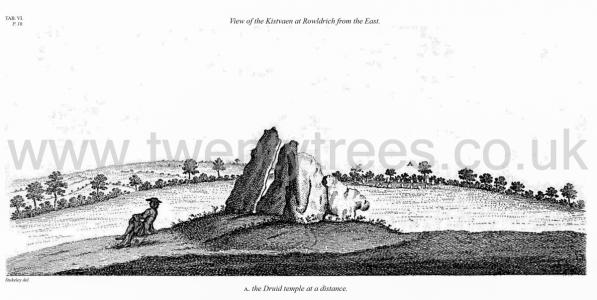 Table VI.
Table VI.
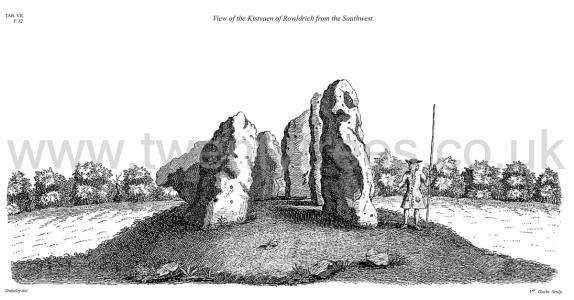 Table VII. View of the Kistvaen of Rowldrich from the Southwest.
Table VII. View of the Kistvaen of Rowldrich from the Southwest.
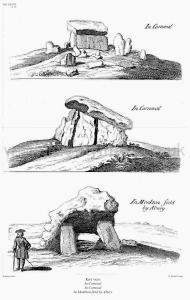 Table XXXVII. Kist vaen In Cornwal, In Cornwal, In Monkton field [Map] by Abury
Table XXXVII. Kist vaen In Cornwal, In Cornwal, In Monkton field [Map] by Abury
Near the arch-druid's barrow, by that called the Kingstone [Map], is a square plat, oblong, formed on the turf. Hither, on a certain day of the year, the young men and maidens customarily meet, and make merry with cakes and ale. And this seems to be the remain of the very ancient festival here celebrated in memory of the interred, for whom the long barrow and temple were made. This was the sepulture of the arch-druid founder. At Enston, a little way off, between Neat Enston and Fulwell, by the side of a bank or tumulus, stands a great stone, with other smaller. 'Tis half a mile south-west of Enston church. A famous barrow at Lineham, by the banks of the Evenlode.
7. Mr. Camden writes further concerning our antiquity, that "the country people have a fond tradition, that they were once men, turned into stones. The highest of all, which lies out of the ring, they call the king [Map]. Five larger stones [Map], which are at some distance from the circle, set close together, they pretend were knights, the ring were common soldiers." This story the country people, for some miles round, are very fond of, and take it very ill if any one doubts of it; nay, they are in danger of being stoned for their unbelief. They have likewise rhymes and sayings relating thereto. Suchlike reports are to be met with in other like works, our Druid temples. They savour of the most ancient and heroic times. Like Perseus, turning men into stones; like Cadmus, producing men from serpents' teeth; like Deucalion, by throwing stones over his head, and such like, which we shall have occasion to mention again, chap. XIV.
8. We may very reasonably affirm, that this temple was built here, on account of this long barrow. And very often in ancient times temples owe their foundation to sepulchres, as well as now. Clemens Alexandrinus in Protrept. and Eusebius, both allow it; and it is largely treated of in Schedius and other authors; 'tis a common thing among these works of our Druids, and an argument that this is a work of theirs. I shall only make two observations therefrom. 1. That it proceeded from a strong notion in antiquity of a future state, and that in respect of their bodies as well as souls; for the temples are thought prophylactic, and have a power of protecting and preserving the remains of the dead. 2. That it was the occasion of consecrating and idolizing of dead heroes, the first species of idolatry; for they by degrees advanced them into those deities of which these figures were symbols, whereof we shall meet with instances in the progress of this work.
Thus we pronounce Rowldrich a Druid temple, from a concurrence of all the appearances to be expected in the case; from its round form, situation on high ground, near springs, on an extended heath, from the stones taken from the surface of the ground, from the name, from the measure it is built on, from the wear of the weather, from the barrows of various kinds about it, from ancient reports, from its apparent conformity to those patriarchal temples mentioned in scripture. This is the demonstration to be expected in such antiquities. Nor shall I spend time in examining the notion of its belonging to Rollo the Dane, and the like. Mr. Camden had too much judgment to mention it. 'Tis confuted in the annotations to Britannia, and in Selden's notes on Drayton's Polyolbion, page 224. And let this suffice for what I can say upon this curious and ancient monument: the first kind, and most common of the Druid temples, a plain circle: of which there are innumerable all over the Britannick isles; being the original form of all temples, 'till the Mosaick tabernacle.